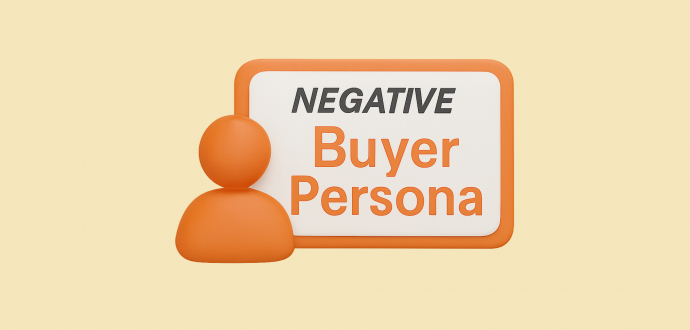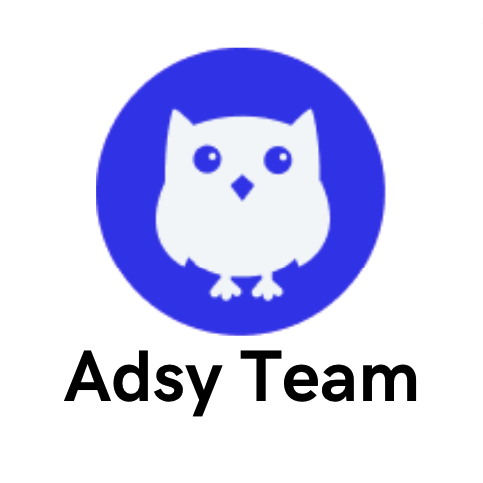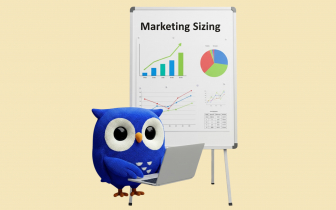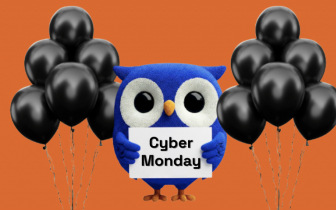How Negative Buyer Personas Can Save Your Business (+ Free Template)

Pretty much everyone has heard of a buyer persona. But when it comes to a negative buyer persona, it still generates lots of questions.
If you are surprised to hear about this, then you are in for a treat.
For any business, every click, prospect, and conversion counts. After all, resources aren’t infinite for most of us.
Now, imagine if all those clicks, prospects, and conversions are actually coming from the wrong people — people who won’t see your product or service as something useful.
It’s painful to even write this. But you can avoid all this drama and waste of time with a negative persona. If you are not sure how this works, then keep reading to find out (we’ve also created a free template for you).
What is a negative buyer persona?
A negative persona is basically the opposite of your usual buyer persona. It is this snapshot of the kind of client you're actively avoiding doing business with (or should be avoiding).
This person or company is just not a good fit for your business. And going after customers like this would inevitably mean a huge waste of time, effort, and resources. It's just not worth it.
Compare that to your usual buyer persona, where you try to capture your dream buyers. You know exactly what their challenges are and how your products/services fit into their lives. It makes your whole marketing easier because you know there’s a high chance they’ll convert.
With the negative persona, it’s clear as day that they don’t belong in your sales funnel. Usually, these are people who don’t need your offering in the first place.
But sometimes, they can include those who do but are too problematic to work with. Maybe they just never pay on time or constantly change their mind about what they want.
Let’s say you’re a guest blog placement service. Chances are, you’d avoid anyone who expects you to publish their articles on Forbes or BBC for $100.
Imagine if they also insist that your link placement guarantees a particular amount of referral traffic in one week. You’d be avoiding their calls like it’s your ex (maybe even more).
Most common examples
So, what do these clients look like in real life? Here are some examples to break it down.
- The freebie hunter. You definitely know this type — they’re forever signing up for free trials on as many tools as possible, but you’d never see them finally committing to one.
- Way too needy. At first glance, they don’t seem so bad. But if you make the mistake of working with them, you’d soon regret it. They always find something wrong that needs your attention. And you end up spending way more time with them than what they pay.
- Out-of-scope. No matter how flexible you try to be, this person just doesn't fit into your ideal customer type. Their needs don’t align with your product or service. Imagine trying to market organic beef to a hardcore vegan.
- Mismatch. On the surface, this kind of person can look like a good prospect. That is, until you take a closer look at them. They have goals or values that just don’t match well with your business practice, no matter how hard you try.
- Vanishing type. Everyone eventually encounters this type of client. They start off with so much enthusiasm, and then, out of nowhere, they vanish.
Of course, there are more types of customers that won't be a fit for you. Still, these are some of the most popular ones that pretty much any business faces at some point.
Why does it matter?
So, why should you create a negative persona in the first place? Well, knowing who isn’t your customer is just as important as knowing who is. These are just a couple of reasons why:
1. Allocate your budget properly
We all know that marketing takes a lot of money, resources, and energy — none of which you have in endless quantities (most likely).
Think about it — it’s typically going to cost you the same amount of time to get both great-fit clients and those that just aren’t a match. So, why would you waste your capacity?
Besides, often, when a customer is just off, you end up having a much higher workload, even though it’s something that clearly wasn’t going to work from the very beginning.
2. Avoid killing morale
If there’s one thing that can kill morale really fast, it’s doing your best but not seeing results for it. That’s what happens when you pour yourself into the wrong buyer type.
Now imagine having to deal with one too many vanishing and mismatched personas in a row. That’s just too much frustration. So, if you want your team to keep up with their motivation, you have to make sure they know whom not to target.
Besides, it will definitely help you reduce churn, which is another thing that can greatly improve your team’s productivity.
3. Know where to channel your efforts for better ROI
You already understand where this one’s going — it’s exactly what it reads like. If you know who not to market to, you can easily choose to focus your attention on worthy prospects.
One thing is for sure: when you invest in the ideal persona types, you get better results.
Plus, your sales team gets to enjoy their work by interacting with customers who are actually interested in your offering and have the potential to convert.
4. Fine-tune your marketing messages
Once you grasp who your perfect clients are and those who don’t fit into that bill, you can tweak your messaging to speak to the right audience.
Often, businesses think that they won’t show their pricing on the website to avoid “scaring off” some prospects. But you might have guessed it already — it’s a wrong move. You want to get qualified leads, not just any random people.
Otherwise, your supposedly target audience could turn into a ghost town that doesn’t react to your communications.
So, long story short — your messaging should exclude those parts of your audience that won’t be a great fit for your business. And a negative persona can help you with that.
5. Improve your product development
Believe it or not, knowing who your audience isn’t can help you improve your product and service. Since you know who your offering is not for, you can now personalize the product/service to fit the right audience.
Nothing worse than listening to feedback from the wrong clients and then trying to change your product to fit their preferences. You just end up losing on both ends.
The wrong people feel it’s not good enough, and the right ones feel it’s not for them either.
How to use this
Now that you know why your negative personas are important. What do you do with all that information?
The truth is, there are plenty of useful ways you can use this to turn your business around. Here are some ideas you can start with:
1. Ad spend optimization
You know what happens when you publish ads, but only the wrong users keep clicking on them? That’s going to be a pure waste of money.
So, one way you can avoid this is by clearly defining who your ads are not for. Basically, you can use negative personas to sieve out low-value leads from ad campaigns. This way, you can avoid wasting your ad spend and still improve your ROI.
How does this work in practice?
Say a SaaS company notices that freelancers looking to get free, limited use of their software make up a majority of their paid clicks. What can they do to optimize their ads?
They can create a persona based on this and label it “freelancer freebie hunter” or anything, really. Easy part, but what do they do with this persona?
They can choose to exclude the traits of that group of leads from their future ads. For instance, adding the phrase “free XYZ tool” to their negative keyword list is one idea. Another solution is to change the messaging and clearly state that your software is for businesses.
As a result, all subsequent ads might get fewer clicks but more quality leads and conversions since they’re coming from actual people who want your product/service and are willing to pay for it.
2. Better sales qualification
Every business wants its sales team to focus its efforts more efficiently. Of course, your buyer personas and ICPs can be really helpful here. But the only lacking component is who you do not want to be your customer.
This is how you can make it easier for your sales reps to spot “dead weight” and channel their efforts where they will pay off. As a result, you get fewer resources wasted, and your team’s productivity increases.
For example, let’s say your sales team has been trying to market to big enterprises that demand a lot of customization but won’t close. Any case like this would mean hours spent on trying to understand and adjust to the needs of clients who can’t even use your solution properly.
But instead of wasting time on getting nowhere, you can have a negative persona for this type of prospect.
The idea is that your sales team will know what objections and red flags to look for during their sales calls. Some of the identifying flags might be that:
- The prospects are forever requesting discounts,
- They keep asking for some specific features that won’t be useful for the rest of your target audience,
- Maybe they don’t have the power to make buying decisions,
- Their roles don’t fit,
- They tend to ghost in the middle of projects.
Any good framework you choose to help you create your persona will always include ways to address those. For example, you can include some guidance for your sales and say that if the prospect constantly asks for X, your team shouldn’t move them to a demo.
This is, for example, one of the sections in our Notion template (you can use it for free through the link below):
[Get the template here for free]
A negative persona with response strategies is a true lifesaver in discovery calls.
When your sales reps identify a wrong fit, they can politely suggest checking other solutions or explain what they can and can’t do. This is one of those less obvious ways that helps you get shorter sales cycles and increase your close rates.
To help you even further, you can use one of the sales qualification frameworks, like CHAMP, for instance.
Source: Salesmate
3. Product development focus
You probably know about the whole feedback loop and its importance in product development.
Source: Maze
Sure, it’s crucial. The best-selling products/services are those made with the users in mind — they perfectly align with their needs and make their lives easier.
But what if you ask the wrong users?
This is a big deal because even the best product and service would attract a lot of criticism if it got into the wrong hands.
It simply won’t align with their needs, and so you'd just end up with way too many irrelevant suggestions that might not even work for your true audience and their needs.
A negative persona can help you avoid falling into the product death cycle phase. This is when the company acts on feedback from the wrong customers (usually the churning ones) and uses that to decide what features to update or add to the product.
Source: LinkedIn
The downside of this is that it never works out. And it makes sense.
You end up building for the wrong buyer who probably won’t hang around long enough to actually use the features or buy the product anyway. Big waste of resources for nothing. Yikes.
So, how do you handle this?
It will be pretty clear once you create your negative personas. But if you don’t have those yet, you might still see some signs that your clients or prospects aren’t a good fit for you.
Say, for instance, your support or development team keeps getting requests from users in industries the product/service was never designed for.
From here, you have two main solutions:
- Politely explain to your clients that you can’t sustain their requests if what they suggest doesn’t make any business sense for you. This will also give you inspiration for another negative persona.
- Alternatively, you can decide that you actually want to include this new feature, industry, etc., into your product/service because it will be useful for you. We’ve also added this option to our template:
As a result, you’ll have a clearer roadmap of what your product should look like. This means you’ll use your resources better and end up with a final solution that has features that are more aligned with your target audience.
4. More targeted messaging that improves results
We all know that content helps attract customers. But sometimes, a website's messaging is so focused on drawing attention to the product that it doesn’t do a great job of highlighting who it is for.
This usually leads to lower conversion rates. People might even be interested and sign up for your offering, but they will never stick around because your product/service was never meant for them. In short, a morale destroyer.
What can you do with this?
You’ve guessed it — use a negative buyer persona framework to know what topics and negative keywords to avoid to not attract the leads you don’t want. So, if your product/service, for example, is not designed for startups, this means you have to clearly specify that.
Besides, find the exact content/messaging that appeals to that audience and let your marketing team know that they shouldn’t use it.
Once you clear this confusion, it’ll be easier to tweak your messaging so it appeals to the right buyer.
5. Improved efficiency
What happens when you get tons of clients who fall under the “high-maintenance umbrella”? You can’t really stretch your team trying to be all (and do it all) for every one of these customers, especially if the math doesn’t work in terms of your ROI.
A better alternative would be to have a negative persona that stands for these too-needy customer types.
You can flag them in your CRM so it’s easy to spot them and hand them over to customer support representatives who are trained to set the right boundaries with this type of buyer.
As a result, your team won’t suffer from burnout for nothing. Instead, you can direct your attention and resources to sustaining your relationship with the existing customers who are a perfect fit for your business.
Create your negative persona in 5 steps
It takes more than just making a list of traits you don’t want in your prospects. You’re going to need the right strategy to save your time, money, and keep growing your company. So, here's our step-by-step guide to get you started:
1. Get accurate data
Most likely, before you get to this point, you have a pretty solid idea of who your ideal customers are. Maybe you also understand who doesn’t really fit. But you do need data to know if you’re actually right, because assumptions alone won’t do. This is where research comes in.
Source: Fluent Forms
You’ll need to collect diverse insights to create an accurate persona. The exact metrics will really depend on your particular case and niche.
But ideally, you want to first ask your team about their most problematic prospects and clients and then try to find patterns there.
For this to be more accurate, talk to as many team members as possible (pretty much anyone who interacts with your customers directly). They’re in the best place to tell you the kind of buyers/prospects that strain resources and waste time.
You can also use your CRM tool or any analytics software to search for any similarities. Watch out for people who:
- Signed up to try your product/service, but then ditched it after a while.
- Those who signed up for free trials from several corporate emails that belong to the same company.
- Those who just ghost your team, no matter how much they fit your ideal customer.
- Yield a low customer lifetime value.
- Consistently churn fast, no matter how hard you try to entice them to stick around.
- Ask for too much customization, even with cheaper plans, etc.
You may be surprised what the data turns up. When you find any similarities, group those leads/buyers and create your personas based on that information.
You might also need to conduct customer surveys to get direct feedback from your clients.
On top of it, take a closer look at your website analytics. Things like bounce rate, conversion drop off points, etc., can all help you catch which part of your traffic stops converting.
And of course, look at obvious things. For example, if a particular landing page, webinar, or lead magnet attracts mostly freelancers while you target SMBs, think about what could trigger this. When you find some messages, keywords, etc., include them in your personas.
2. Find the patterns and solve the puzzle
We’ve already touched on this above. But this is really the most important part.
All that data you’ve collected simply means it’s time to have some fun brainstorming sessions. The idea is to find the traits and behaviors that appear repeatedly. You might notice that lost prospects and former customers fall into one or more of these groups:
- People with a tight budget who can’t afford your product/service, and constantly ask for discounts.
- Those who want features you don’t offer or don’t have the problems your product is designed to solve.
- Customers who simply like the thrill of jumping onto the next new tool every few months.
- Those who don’t have the power to make the buying decisions.
- Those in the wrong industry, etc.
Obviously, you aren’t doing this for just funsies. So, be sure to find the common reasons for ditching your service or product. The truth is, you’ll probably find several explanations once you start looking.
Of course, it is important to know why some people choose your competitors when you can help them. But it’s absolutely crucial to understand how to avoid the time-drainers.
3. Create several profiles
This point is just a reminder that you can have as many negative personas as you wish.
Ideally, you need to have one fundamental motivation/objection per persona (you can go back above to check different types for inspiration).
Trying to fit everything into one template will usually end up being messy and hard for your team to use.
These profiles are only helpful when your sales, marketing, or customer support know exactly who they’re dealing with and where to look for their “preferred responses.”
4. Create your profiles
Now, when you’ve covered all the essentials, you can start creating your personas.
Here are the most important things to keep in mind:
- Use any format, but make sure it’s collaborative because the input from different departments is very important.
- Feel free to include demographic data, but don’t make it your main focus. Typically, you have to concentrate on motivations and real issues, not the basic information.
- Make your personas actionable. Of course, all this info is good to know. Yet, you want to give your teams clear guidelines on how to act when they deal with a prospect or client like that.
- Add some framework that can help you fix the whole situation. If you don’t want to deal with these leads and customers, think about how you can avoid getting them in your funnel in the first place.
If all this sounds a bit complicated and you don’t know where to start, the next section is for you.
5. Use our free template
Why create a negative buyer persona template from scratch when you can use one already made for you?
We’ve prepared a Notion framework with all the essential sections:
- Red flags and typical objections,
- Analysis of how these prospects find you (aka acquisition channels),
- Response strategy for marketing and sales,
- Changes you have to make to avoid attracting these leads (and changes tracker),
- Alternative plan if you want to serve these prospects with a different product/service.
[Get the template here for free]
You can use it directly in Notion or copy-paste it elsewhere if it’s more convenient for you. But make sure your format allows your team to collaborate. Because your personas will be much more detailed and accurate if different departments contribute.
Conclusion
The truth is that in business, all resources count, and so everyone needs to create a negative buyer persona to avoid wasting theirs.
When it becomes clear who you shouldn’t target, you can easily save your time and energy for the people likely to boost your ROI.
This way, you will keep morale high, reduce the chances of anyone having to suffer burnout, and increase sales rates.







